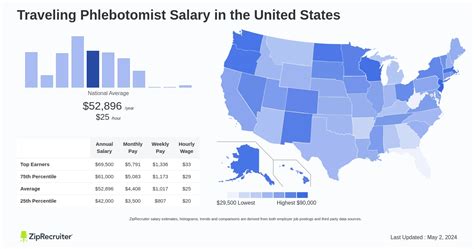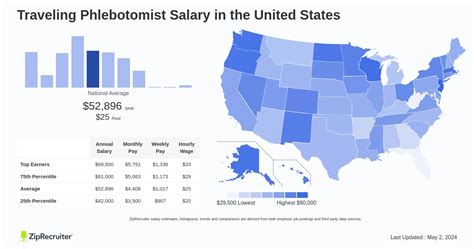For healthcare professionals who crave flexibility, variety, and a dynamic work environment, the role of a traveling phlebotomist offers an exciting and financially rewarding career path. This in-demand profession not only provides the opportunity to work in diverse settings across the country but also comes with a significant salary premium compared to stationary roles.
If you're considering this unique career, your first question is likely about compensation. The truth is, a traveling phlebotomist can earn an impressive salary, with many professionals seeing annual incomes ranging from $45,000 to over $70,000, including stipends and allowances. In this detailed guide, we will break down the salary you can expect and the key factors that will influence your total earnings.
What Does a Traveling Phlebotomist Do?


At its core, a traveling phlebotomist's primary responsibility is to draw blood samples from patients for testing, transfusions, research, or donations. However, the "traveling" aspect adds a layer of adaptability and independence to the role. Instead of working in a single hospital or clinic, a traveling phlebotomist takes on temporary assignments in various locations.
Their daily responsibilities include:
- Traveling to assigned locations, which could be hospitals, clinics, long-term care facilities, mobile blood donation centers, or even patients' homes.
- Correctly identifying patients and verifying medical orders.
- Skillfully performing venipuncture, finger pricks, or heel pricks to obtain blood samples.
- Calming and reassuring nervous or anxious patients.
- Labeling, storing, and preparing samples for transport to a laboratory.
- Adhering to strict safety and infection control protocols.
This role is ideal for certified professionals who are highly organized, self-motivated, and possess excellent interpersonal skills.
Average Traveling Phlebotomist Salary


While the U.S. Bureau of Labor Statistics (BLS) provides a strong baseline, it's important to differentiate between general phlebotomist pay and the specialized compensation for travel roles.
The BLS reports the median annual wage for all phlebotomists was $41,810 as of May 2023, with the top 10% earning more than $54,930 (U.S. Bureau of Labor Statistics, 2024).
However, traveling phlebotomists typically earn significantly more. This is because their compensation is often structured as a "blended" package, which includes a lower taxable hourly wage combined with substantial non-taxable stipends for housing, meals, and incidentals. This structure is what pushes their take-home pay much higher.
Based on data from reputable salary aggregators and industry staffing agencies:
- Salary.com notes that the average mobile phlebotomist salary in the United States is around $43,923, but the range typically falls between $39,584 and $49,089 (Salary.com, 2024).
- Glassdoor reports a higher potential, with an estimated total pay for a traveling phlebotomist at $66,356 per year, including a base salary and additional pay like bonuses or profit sharing (Glassdoor, 2024).
- Travel healthcare staffing agencies often advertise contract positions with weekly gross pay ranging from $1,500 to over $2,200, which translates to an annualized income of $60,000 to $88,000 or more, depending on the assignment's location and urgency.
The takeaway is clear: choosing a traveling career path can boost a phlebotomist's earning potential by 25-50% or more compared to a permanent position.
Key Factors That Influence Salary


Your exact salary as a traveling phlebotomist will depend on a combination of critical factors. Understanding these variables can help you maximize your income throughout your career.
###
Level of Education and Certification
While a postsecondary nondegree award is the typical entry-level education, holding nationally recognized certifications is the single most important educational factor for increasing your pay. Certifications demonstrate a standardized level of competency and are highly valued by employers and staffing agencies. Key certifications include:
- Phlebotomy Technician (PBT) from the American Society for Clinical Pathology (ASCP)
- Certified Phlebotomy Technician (CPT) from the National Healthcareer Association (NHA)
- Registered Phlebotomy Technician (RPT) from the American Medical Technologists (AMT)
Holding one or more of these credentials not only makes you more hirable for premier travel assignments but also gives you leverage to negotiate for a higher base pay rate.
###
Years of Experience
Experience is paramount in healthcare. An experienced phlebotomist who can confidently handle difficult draws (e.g., geriatric, pediatric, or oncology patients), work with minimal supervision, and adapt quickly to new electronic health record (EHR) systems is a highly valuable asset.
- Entry-Level (0-2 years): New traveling phlebotomists can expect to earn on the lower end of the travel salary spectrum but still significantly more than a stationary entry-level role.
- Mid-Career (3-8 years): With several years of experience, you can command higher-paying contracts in more desirable locations.
- Senior-Level (8+ years): Highly experienced professionals can access the most lucrative contracts, including rapid-response assignments that offer premium crisis rates.
###
Geographic Location
For a traveling professional, location impacts salary in two ways: the state of your assignment and the local cost of living. States with a high cost of living and high demand for healthcare workers typically offer the best pay packages. According to BLS data from May 2023, the top-paying states for phlebotomists (a strong indicator for travel pay) are:
1. California ($54,050 average)
2. District of Columbia ($51,550 average)
3. Massachusetts ($49,760 average)
4. Washington ($49,270 average)
5. New York ($48,820 average)
Securing a travel contract in a major metropolitan area within these states will almost always yield a higher weekly stipend and overall pay package than an assignment in a rural, low-cost-of-living area.
###
Company Type
The type of employer you work for plays a significant role in your compensation structure.
- Travel/Staffing Agencies: These companies are the most common employers for traveling phlebotomists. They specialize in filling short-term needs and typically offer the highest gross pay packages, which include the blended rate of a taxable wage and non-taxable stipends.
- National Laboratories (e.g., Labcorp, Quest Diagnostics): These large companies often employ their own internal pool of mobile phlebotomists who travel within a region to cover patient service centers or perform at-home draws for insurance exams. The pay is competitive and often comes with robust corporate benefits, though the stipends may be less generous than with agency work.
- Hospital Networks: Some large hospital systems hire traveling phlebotomists to float between their various facilities. This can provide more stability than agency work but with slightly lower peak earning potential.
###
Area of Specialization
Developing a niche skill set can make you a more attractive candidate and boost your earnings. Specializations that command higher pay include:
- Plasmapheresis/Apheresis: Working in plasma or blood component donation centers requires specialized training and often pays a premium.
- Pediatric Phlebotomy: Skill in working with infants and children is a highly sought-after specialty.
- Therapeutic Phlebotomy: Performing blood draws as a treatment for medical conditions like polycythemia vera or hemochromatosis is a specialized clinical skill.
- Mobile Examiner: Working as an independent contractor performing blood draws and collecting specimens for life insurance companies can be very lucrative.
Job Outlook


The future for phlebotomists is incredibly bright. According to the U.S. Bureau of Labor Statistics, employment for phlebotomists is projected to grow 8 percent from 2022 to 2032, which is much faster than the average for all occupations.
This robust growth is driven by the overall expansion of the healthcare industry. As the population ages and preventive medicine becomes more common, the need for diagnostic blood testing will continue to rise. This sustained demand ensures strong job security and continued opportunities for both stationary and traveling phlebotomists for years to come.
Conclusion


A career as a traveling phlebotomist is more than just a job—it's an adventure that offers professional growth, personal freedom, and outstanding financial rewards. While the national median salary for phlebotomists provides a starting point, the true earning potential for a traveling professional is significantly higher, often exceeding $70,000 per year for experienced and well-placed individuals.
By focusing on obtaining key certifications, gaining diverse experience, and strategically choosing assignments in high-demand locations, you can build a fulfilling and lucrative career on the road. With a strong job outlook and a clear path to a high salary, now is an excellent time to explore the dynamic world of travel phlebotomy.
